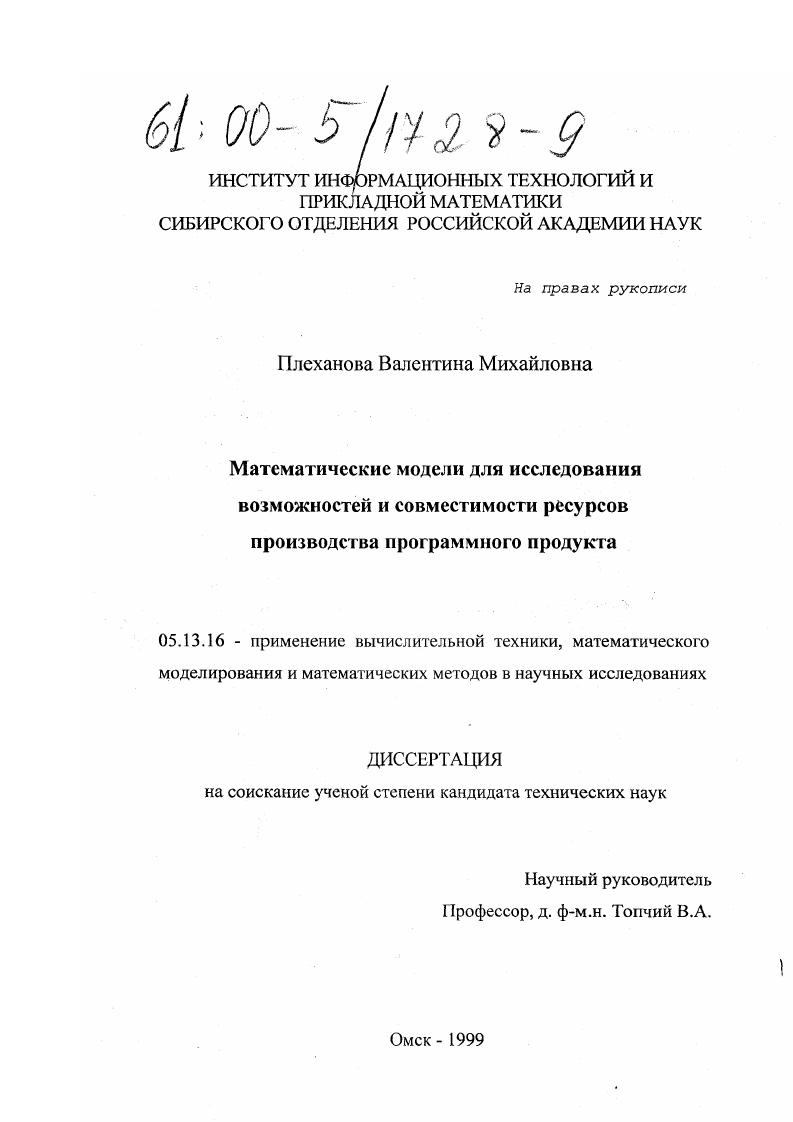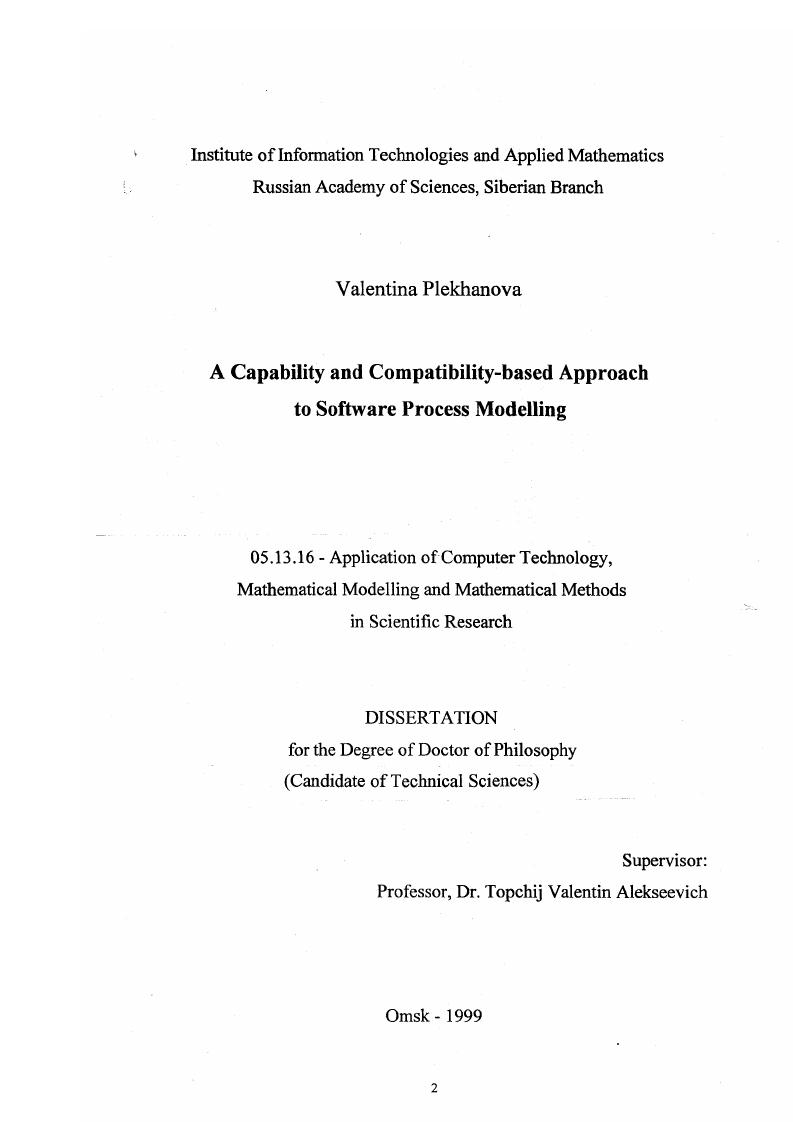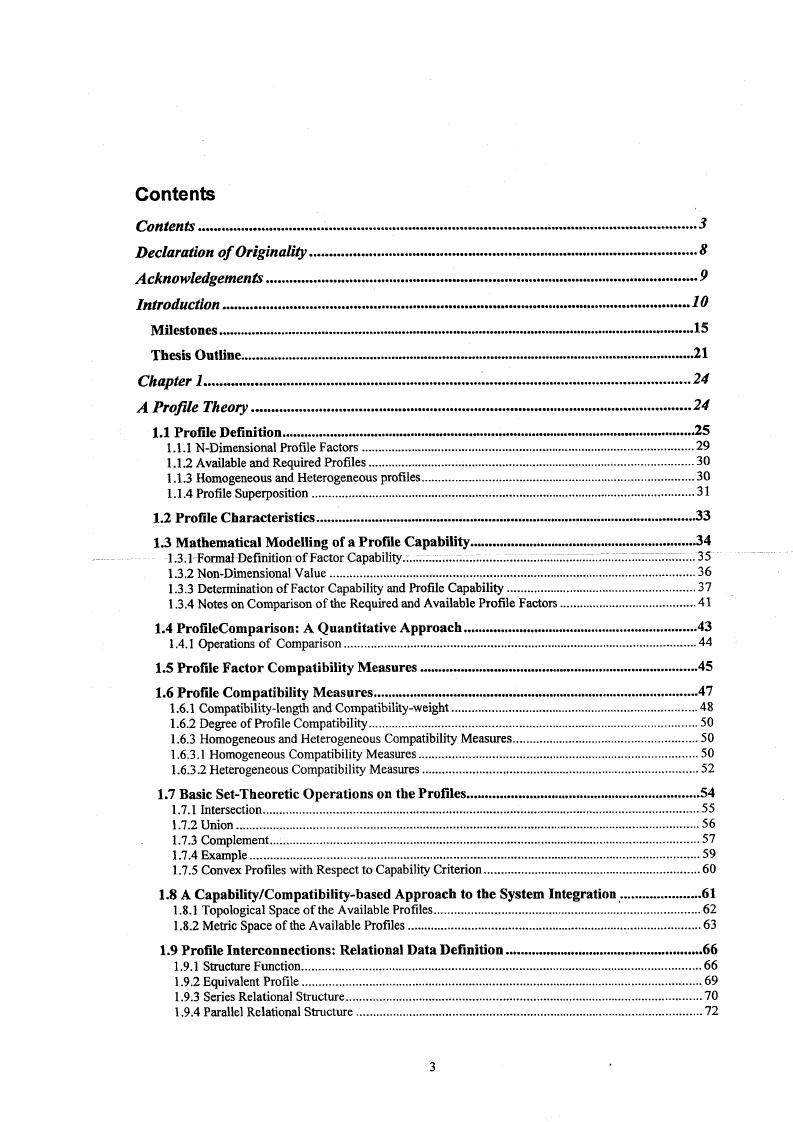Математические модели для исследования возможностей и совместимости ресурсов производства программного продукта

- Автор:
Плеханова, Валентина Михайловна
- Шифр специальности:
05.13.16
- Научная степень:
Кандидатская
- Год защиты:
1999
- Место защиты:
Омск
- Количество страниц:
339 с. : ил.
Стоимость:
700 р.499 руб.


Institute of Information Technologies and Applied Mathematics Russian Academy of Sciences, Siberian Branch
Valentina Plekhanova
A Capability and Compatibility-based Approach to Software Process Modelling
05.13.16 - Application of Computer Technology, Mathematical Modelling and Mathematical Methods in Scientific Research
DISSERTATION for the Degree of Doctor of Philosophy (Candidate of Technical Sciences)
Supervisor:
Professor, Dr. Topchij Valentin Alekseevich
Omsk
Contents
Contents
Declaration of Originality
Acknowledgements
Introduction
Milestones
Thesis Outline
Chapter
A Profile Theory
1.1 Profile Definition
1.1.1 N-Dimensional Profile Factors
1.1.2 Available and Required Profiles
1.1.3 Homogeneous and Heterogeneous profiles
1.1.4 Profile Superposition
1.2 Profile Characteristics
1.3 Mathematical Modelling of a Profile Capability
1.3.1 Formal Definition of Factor Capability
1.3.2 Non-Dimensional Value
1.3.3 Determination of Factor Capability and Profile Capability
1.3.4 Notes on Comparison of the Required and Available Profile Factors
1.4 ProfileComparison: A Quantitative Approach
1.4.1 Operations of Comparison
1.5 Profile Factor Compatibility Measures
1.6 Profile Compatibility Measures
1.6.1 Compatibility-length and Compatibility-weight
1.6.2 Degree of Profile Compatibility
1.6.3 Homogeneous and Heterogeneous Compatibility Measures
1.6.3.1 Homogeneous Compatibility Measures
1.6.3.2 Heterogeneous Compatibility Measures
1.7 Basic Set-Theoretic Operations on the Profiles
1.7.1 Intersection
1.7.2 Union
1.7.3 Complement
1.7.4 Example
1.7.5 Convex Profiles with Respect to Capability Criterion
1.8 A Capability/Compatibility-based Approach to the System Integration
1.8.1 Topological Space of the Available Profiles
1.8.2 Metric Space of the Available Profiles
1.9 Profile Interconnections: Relational Data Definition
1.9.1 Structure Function
1.9.2 Equivalent Profile
1.9.3 Series Relational Structure
1.9.4 Parallel Relational Structure
1.9.5 Discretionary Relational Structure
1.9.6 Structure with Compatibility-weight
1.10 A Fuzzy-Set-Theoretic Approach to Profile Modelling
1.10.1 Convex Fuzzy Profiles
1.11 Evolution Characteristics
1.11.1 Evolution Power
1.11.2 Compatibility of Evolution Power
1.11.3 Factor Level Evolution Characteristics
1.11.4 Applications: Learning Capability Characteristics
1.12 Object Integration Management
1.13 Summary of Chapter
1.14 Further Directions of the Profile Theory Development
Chapter
A Synergistic Approach to Process Modelling
2.1 Modelling Terminology
2.2 An Integrated Process Modelling Environment
2.3 Synergism in Process Modelling
2.4 Process System Integration: Capability and Compatibility Factors
2.5 Summary of Chapter
Chapter
A Framework for Capability-based Approach to a Modelling of Project Resources
3.1 A Formal Description of Human Resources
3.2 Human Resource Modelling: Human-Software Environment
3.2.1 Basic Notions of Human-Software Environment
3.2.2 HSE Characteristics
3.2.3 Outlines of the Techniques for Obtaining Knowledge/Skill Profiles
3.3 Human Resource Analysis
3.3.1 A Set-Theoretic Approach to Human Resource Analysis: An Illustrative Example
3.3.2 A Quantitative Approach to Human Resource Analysis
3.4 HSE Modelling
3.4.1 Team Modelling: The HSE as a Topological Space
3.4.2 Team Modelling: The HSE as a Metric Space
3.5 On the Ream Relational Data
3.5.1 Series Relational Structure ofthe HSE
3.5.2 Parallel Relational Structure of the HSE
3.5.3 Discretionary Relational Structure of the HSE
3.6 Performance Constraints Determination on the Structure
3.7 Project resource Integration management in Software Process Improvement
3.8 Compatibility of Project Resources: A Problem of Project Resource Integration
Management
3.8.1 Compatibility Problem: Project Requirements with CASE Tools - An Example
3.8.2 Human Resource Compatibility with CASE Tools - An Example
Chapter 1. A Profile Theory
where U, = E, xV, x W
1.3.1 Formal Definition of Factor Capability and Profile Capability
In order to determine an integrated quantity when a factor is represented by triplicate parameters (time ei, level v, , and weight w,), a single parameter, volume, is defined. Since we are interested in a quantitative value (just single integrated parameter instead of triple) at the particular point of time, calculation of volume gives only an integrated quantity (not functional relationships between s,, v,, w,). Notice that the definition of the functional relationship(s) between these parameters is not considered. This subsection introduces the quality characteristics that represent the capabilities of a profile and its factors by capturing the factor characteristics e,, v,, w,
We define the ith factor integrated capability V (bt) or Vi as an element of volume:
(1.3.1.1)
for N-dimensional factor capability (Section 1.1.1):
(1.3.1.2)
Рекомендуемые диссертации данного раздела
| Название работы | Автор | Дата защиты |
|---|---|---|
| Математическое моделирование процессов распространения примесей в атмосфере и программная реализация информационно-аналитической системы природоохранных служб | Якубайлик, Олег Эдуардович | 1998 |
| Численный анализ электрогидродинамической неустойчивости слоя вязкой жидкости на твердом дне | Муничев, Михаил Иванович | 1997 |
| Модели и метод параметрической оптимизации измерительных преобразователей стохастических сигналов | Кузнецов, Борис Федорович | 1999 |